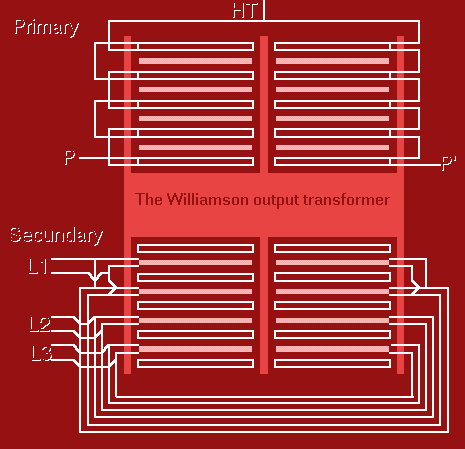The Output Transformer. |
|||||
|
The output transformer Williamson proposed was a bulky one. Its core was equal to the DIN E-I 150 that is used nowadays. The core is 150mm High (6'') and with the copper weighted 6kg. (13lbs). The core material was at that time a premium quality but to modern standards it is only standard grade. The reason Williamson used such a core was that he wanted to reach an initial inductance of 100H and a max. inductance of 600H. This can only be reached with a enormous core and 4400 turns with a standard grade core. To keep the leakage inductance within acceptable margins the primary is divided in two mirror-identical sections that are each divided in 5 sections of 4 layers of 88 turns of 0.3mm copper. In between those 5 primary sections are 4 secondary sections consisting of 2 layers of 44 turns of 1.2mm. ( 1''=25mm). All layer are insulated with 0.05mm paper and all sections are interleaved with 0.4mm insulating linen tape. The drawing gives an impression of how things are connected. |
|||||
 |
|||||
|
All primary coils are in series and the secondary can be connected in series and parallel thus giving the loudspeaker impedance's of 1.7, 6.8 and 15.2 Ohms. This transformer works! For those who want to try it themselves to make such a transformer the author found out that it is not entirely impossible with a winding machine. The most important feature of such a machine is a reliable mechanical counter. The transformer, although it is very good is somewhat out of time. The dimensions are not very practical, the copper losses in the primary are with 250 Ohms between the plates somewhat high and a leakage induction with 30mH somewhat high and last but not least, the output impedance's are impractical. And yet, the author has a pair of transformers that are wound exactly to the Williamson specs, it sounds wonderful. The first thing you must know about output transformers is that the square root of the impedance ratio in the turn ratio. (the quadrate of the turn ratio is….) The second thing, leakage inductance can easily be measured with a LCR meter. Short the secondary and measure the inductance that is left over in the primary. Don't be surprised when it is much lower as 30mH. The author reached values as low as 3.8 mH. The selfinductance of the entire transformer is not so easy to measure since it depends on the excitation of the iron core. Therefore it is more practical to measure the initial selfinductance at 5 volts. If one connects the primary to a 5 V ac supply with a ammeter in series one must measure less then 100microamps for an acceptable transformer. Since the quality of core material has improved enormously over the years it is not impossible to use a smaller core of grain oriented material with somewhat less turns and still reach a higher primary inductance. Although it is possible to calculate everything of a transformer it is hard to say how a transformer performs once it is wound. The best guaranty that a do it yourself transformer works is sticking to the original Williamson design and diminish the diameter so that you reach a turn ratio of 35 when the entire secondary is connected in two parallel sections that are put in series. You can also develop a transformer yourself and make use of the modern materials. Be prepared for dozens of transformers that look nice on paper but for reasons that will remain unknown (till you are wiser) don't sound any good. Reject the transformers that don't sound at all and improve the ones that seem better. It is learning the hard way as the author experienced. The author has after years finally developed a transformer that is better then the original Williamson on a E-I 130B core of grain oriented material. It has sectional windings, has a leakage inductance of 8mH, 120 Ohms dc between the plates, 0.14 Ohm dc secondary and has a secondary impedance of 8 Ohms to a primary of 9000 Ohms. It has connections for ultra linear use with other constructions. Its still weighs 4 Kg (9lbs). The winding details are undisclosed. If you are interested in commercial production of a very good transformer the author is interested in selling his pair of transformers exclusively to you including the winding details. Remember that the development took 2 years and that the negotiation base is two years of wages. For information on this subject please mail ideas@xs4all.nl mentioning OPT as subject. |
|||||
|
|||||